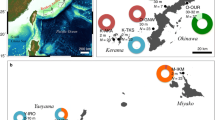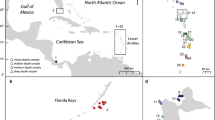Abstract
Spatial models of genetic structure and potential gene flow were determined for five populations of Balanophyllia europaea, a simultaneous hermaphroditic and brooding coral, endemic to the Mediterranean. Six allozyme loci indicated a genetic structure that departed markedly from Hardy–Weinberg equilibrium, with a significant lack of heterozygotes. The genetic structure observed supports the hypothesis that self-fertilisation characterises the reproductive biology of B. europaea. Populations at small spatial scales (8–40 m) are genetically connected, while those at large scales (36–1,941 km) are genetically fragmented; the genetic differentiation of the populations is not correlated to geographic separation. This spatial model of genetic structure is compatible with an inbreeding mating system. Furthermore, it is also consistent with the expected dispersal potential of swimming larvae of brooding corals, i.e. larvae that are able to produce significant gene flows only within limited spatial scales.

Similar content being viewed by others
References
Ayre DJ, Dufty S (1994) Evidence for restricted gene flow in the viviparous coral Seriatopora hystrix on Australia’s Great Barrier Reef. Evolution 48:1183–1201
Ayre DJ, Hughes TP (2000) Genotypic diversity and gene flow in brooding and spawning corals along the Great Barrier Reef, Australia. Evolution 54:1590–1605
Ayre DJ, Resing JM (1986) Sexual and asexual production of planulae in reef corals. Mar Biol 90:187–190
Ayre DJ, Read J, Wishart J (1991) Genetic subdivision within the eastern Australian population of the sea anemone Actinia tenebrosa. Mar Biol 109:379–390
Ayre DJ, Davis AR, Billingham M, Llorens T, Styan C (1997a) Genetic evidence for contrasting patterns of dispersal in solitary and colonial ascidians. Mar Biol 130:51–62
Ayre DJ, Hughes TP, Standish RJ (1997b) Genetic differentiation, reproductive mode, and gene flow in the brooding coral Pocillopora damicornis along the Great Barrier Reef, Australia. Mar Ecol Prog Ser 159:175–187
Barret SCH, Harder LD (1996) Ecology and evolution of plant mating. Trends Ecol Evol 11:73–79
Bastidas C, Benzie JAH, Fabricius KE (2002) Genetic differentiation among populations of the brooding soft coral Clavularia koellikeri on the Great Barrier Reef. Coral Reefs 21:233–241
Black KP, Moran PJ, Hammond LS (1991) Numerical models show coral reefs can be self-seeding. Mar Ecol Prog Ser 74:1–11
Bohonak AJ (1999) Dispersal, gene flow and population structure. Q Rev Biol 74:21–45
Brazeau DA, Gleason DF, Morgan ME (1998) Self-fertilization in brooding hermaphroditic Caribbean corals: evidence from molecular markers. J Exp Mar Biol Ecol 231:225–238
Brown AHD (1978) Isozymes, plant population genetic structure, and genetic conservation. Theor Appl Genet 52:145–157
Bucklin A, Hedgecock D, Hand C (1984) Genetic evidence of self-fertilization in the sea anemone Epiactis prolifera. Mar Biol 109:379–390
Cairns DS (1977) Biological results of the University of Miami deep-sea expedition, vol 121. A review of the recent species of Balanophyllia (Anthozoa: Scleractinia) in the western Atlantic, with descriptions of four new species. Proc Biol Soc Wash 90:132–148
Carlon DB (1999) The evolution of mating systems in tropical reef corals. Trends Ecol Evol 14:491–495
Cohen S (1992) Population biology of two species of Corella: mating system and demography. PhD thesis, University of Washington, Seattle
Dai CF, Fan TY, Yu JK (2000) Reproductive isolation and genetic differentiation of a scleractinian coral Mycedium elephantotus. Mar Ecol Prog Ser 201:179–187
Edmands S, Potts DC (1997) Population genetic structure in brooding sea anemones (Epiactis spp.) with contrasting reproductive modes. Mar Biol 127:485–498
Fadlallah YH (1983) Population dynamics and life history of a solitary coral, Balanophyllia elegans, from Central California. Oecologia 58:200–207
Frankham R (1995) Conservation genetics. Annu Rev Genet 29:305–307
Furman E (1990) Self-fertilization in Balanus improvisus Darwin. J Mar Biol Assoc UK 70:721–740
Gerrodette T (1981) Dispersal of the solitary coral Balanophyllia elegans by demersal planular larvae. Ecology 62:611–619
Ghiselin MT (1969) The evolution of hermaphroditism among animals. Q Rev Biol 44:189–208
Goffredo S (1999) Population dynamics and reproductive biology of the solitary coral Balanophyllia europaea (Anthozoa, Scleractinia) in the northern Tyrrhenian Sea. PhD thesis, University of Bologna, Bologna
Goffredo S, Telò T (1998) Hermaphroditism and brooding in the solitary coral Balanophyllia europaea (Cnidaria, Anthozoa, Scleractinia). Ital J Zool 65:159–165
Goffredo S, Zaccanti F (2004) Laboratory observations on larval behavior and metamorphosis in the Mediterranean solitary coral Balanophyllia europaea (Scleractinia, Dendrophylliidae). Bull Mar Sci (in press)
Goffredo S, Telò T, Scanabissi F (2000) Ultrastructural observations of the spermatogenesis of the hermaphroditic solitary coral Balanophyllia europaea (Anthozoa, Scleractinia). Zoomorphology 119:231–240
Goffredo S, Arnone S, Zaccanti F (2002) Sexual reproduction in the Mediterranean solitary coral Balanophyllia europaea (Scleractinia, Dendrophylliidae). Mar Ecol Prog Ser 229:83–94
Goffredo S, Mattioli G, Zaccanti F (2004) Growth and population dynamics model of the Mediterranean solitary coral Balanophyllia europaea (Scleractinia, Dendrophylliidae). Coral Reefs (in press)
Goudet J (1995) FSTAT (version 1.2): a computer program to calculate F-statistic. J Hered 86:485–486
Goudet J (2001) A program to estimate and test gene diversities and fixation indices (version 2.9.3). Available from http://www.unil.ch/izea/softwares/fstat.html
Grosberg RK (1991) Sperm-mediated gene flow and the genetic structure of a population of the colonial ascidian Botryllus schlosseri. Evolution 45:130–142
Grunbaum BW (1981) Handbook for forensic individualization of human blood and bloodstain. Library of Congress catalog card no. 80, Sartorius, Hayward
Harper JL (1977) Population biology of plants. Academic, London
Harrison PL (1985) Sexual characteristics of scleractinian corals: systematic and evolutionary implications. In: Gabrié C, et al (eds) Proc 5th Int Coral Reef Symp, vol 4. Antenne Museum—EPHE, Moorea, Tahiti, pp 337–342
Harrison PL, Wallace CC (1990) Reproduction, dispersal and recruitment of scleractinian corals. In: Dubinsky Z (ed) Ecosystems of the world, vol 25. Coral reefs. Elsevier, Amsterdam, pp 133–207
Hedgecock D (1986) Is gene flow from pelagic larval dispersal important in the adaptation and evolution of marine invertebrates? Bull Mar Sci 39:550–564
Hellberg ME (1994) Relationships between inferred levels of gene flow and geographic distance in philopatric coral, Balanophyllia elegans. Evolution 48:1829–1854
Hellberg ME (1995) Stepping-stone gene flow in the solitary coral Balanophyllia elegans: equilibrium and nonequilibrium at different spatial scales. Mar Biol 123:573–582
Hellberg ME (1996) Dependence of gene flow on geographic distance in two solitary corals with different larval dispersal capabilities. Evolution 50:1167–1175
Highsmith RC (1982) Reproduction by fragmentation in corals. Mar Ecol Prog Ser 7:207–226
Jackson JBC (1986) Modes of dispersal of clonal benthic invertebrates: consequences for species distributions and genetic structure of local populations. Bull Mar Sci 39:588–606
Jarne P, Charlesworth D (1993) The evolution of the selfing rate in functionally hermaphrodite plants and animals. Annu Rev Ecol Syst 24:441–466
Jarne P, Charlesworth D (1996) Hermes meets Aphrodite: an animal perspective. Trends Ecol Evol 11:105–107
Jarne P, Vianey-Liaud M, Delay B (1993) Selfing and outcrossing in hermaphrodite freshwater gastropods (Basommatophora): where, when and why? Biol J Linn Soc 49:99–125
Kimura M, Weiss GH (1964) The stepping stone model of population structure and the decrease of genetic correlation with distance. Genetics 49:561–576
Knowlton N, Jackson JBC (1993) Inbreeding and outbreeding in marine invertebrates. In: Thornhill NW (ed) The natural history of inbreeding and outbreeding: theoretical and empirical perspectives. University of Chicago, Chicago, pp 200–249
Kojis BL, Quinn NJ (1981) Aspects of sexual reproduction and larval development in the shallow water hermatypic coral, Goniastrea australensis. Bull Mar Sci 31:558–573
Levene H (1949) On a matching problem arising in genetics. Ann Math Stat 20:91–94
McFadden CS (1997) Contributions of sexual and asexual reproduction to population structure in the clonal soft coral Alcyonium rudyi. Evolution 51:112–126
McFadden CS, Donahue R, Hadland BK, Weston R (2001) A molecular phylogenetic analysis of reproductive trait evolution in the soft coral genus Alcyonium. Evolution 55:54–67
Meera-Khan P (1971) Enzyme electrophoresis on cellulose acetate gel: zymogram patterns in man–mouse and man–Chinese hamster somatic cell hybrids. Arch Biochem Biophys 145:470–483
Miller KJ (1997) Genetic structure of black coral populations in New Zealand’s fiords. Mar Ecol Prog Ser 161:123–132
Mogie M (1992) The evolution of asexual reproduction in plants. Chapman and Hall, London
Mundy CN, Babcock RC (1998) Role of light intensity and spectral quality in coral settlement: implications for depth-dependent settlement? J Exp Mar Biol Ecol 223:235–255
Muscatine L, Cernichiari E (1969) Assimilation of photosynthetic products of zooxanthellae by a reef coral. Biol Bull (Woods Hole) 137:506–523
Nei M (1973) Analysis of gene diversity in subdivided populations. Proc Natl Acad Sci 70:3321–3323
Nei M (1978) Estimation of average heterozygosity and genetic distance from a small number of individuals. Genetics 89:583–590
Neigel JE (2002) Is Fst obsolete? Conserv Genet 3:167–173
Palumbi SR (1992) Marine speciation on a small planet. Trends Ecol Evol 7:114–118
Palumbi SR (1994) Genetic divergence, reproductive isolation, and marine speciation. Annu Rev Ecol Syst 25:547–572
Palumbi SR, Wilson AC (1990) Mitochondrial DNA diversity in the sea urchins Strongylocentrotus purpuratus and S. droebachiensis. Evolution 44:403–415
Pusey A, Wolf M (1996) Inbreeding avoidance in animals. Trends Ecol Evol 11:201–206
Raymond M, Rousset F (1995) Population genetics software for exact tests and ecumenicism. J Hered 86:248–249
Richmond R (1987) Energetics, competency, and long-distance dispersal of planula larvae of the coral Pocillopora damicornis. Mar Biol 93:527–533
Roberts CM (1998) Connectivity and management of Caribbean coral reefs. Science 278:1454–1457
Schneppenheim R, MacDonald CM (1984) Genetic variation and population structure of krill (Euphausia superba) in the Atlantic sector of Antarctic waters and off the Antarctic Peninsula. Polar Biol 3:19–28
Schoen DJ, Brown AHD (1991) Intraspecific variation in population gene diversity and effective population size correlates with the mating system in plants. Proc Natl Acad Sci 88:4494–4497
Slatkin M (1993) Isolation by distance in equilibrium and non-equilibrium populations. Evolution 47:264–279
Slatkin M, Barton NH (1989) A comparison of three indirect methods for estimating average levels of gene flow. Evolution 43:1349–1368
Stoddart JA (1983) Asexual production of planulae in the coral Pocillopora damicornis. Mar Biol 76:279–284
Tomlinson J (1966) The advantages of hermaphroditism and parthenogenesis. J Theor Biol 11:54–58
Uyenoyama MK, Holsinger KH, Waller DM (1993) Ecological and genetic factors directing the evolution of self-fertilization. In: Futuyma D, Antonovics J (eds) Oxford surveys in evolutionary biology, vol IX. Oxford University Press, Oxford, pp 327–382
Veron JEN (1995) Corals in space and time: the biogeography and evolution of Scleractinia. Union of New South Wales Press, Sydney
Weir BS, Cockerham CC (1984) Estimating F-statistics for the analysis of population structure. Evolution 38:1358–1370
Whitlock MC, McCauley DE (1999) Indirect measures of gene flow and migration: Fst≠1/(4Nm+1). Heredity 82:117–125
Willis BL, Oliver JK (1990) Direct tracking of coral larvae: implications for the dispersal of planktonic larvae in topographically complex environments. Ophelia 32:145–162
Wolanski E (1994) Physical oceanographic processes of the Great Barrier Reef. CRC Press, London
Wright S (1943) Isolation by distance. Genetics 28:114–138
Wright S (1969) Evolution and the genetics of natural population, vol 2. The theory of gene frequencies. University of Chicago Press, Chicago
Wright S (1978) Evolution and the genetics of natural populations, vol 4. Variability within and among natural populations. University of Chicago Press, Chicago
Zibrowius H (1980) Les scléractiniaires de la Méditerraée et de l’Atlantique nord-oriental. Mem Inst Oceanogr (Monaco) 11:1–284
Acknowledgements
We thank the Italian Ministry of Education, University and Research, the Scuba Schools International Italia and the Underwater Life Project, our sponsors for this study. We also thank B. Mantovani for her generosity in supplying the research methodology and for her revision of this paper; M. Passamonti for his help in the laboratory and with the statistical analyses; M. Abbiati for his help in electrophoretic techniques; A. Marino for his recommendations on software; our divers E. Manzardo, M. Pasquini and M. Longagnani for their help in sample collection; the Bologna Scuba Team school for its logistical support of the dives; and the Marine Science Group for its scientific and technological contributions. N.E. Chadwick-Furman (Interuniversity Institute for Marine Science at Eilat, Israel), J. Hall-Spencer (University of Glasgow, United Kingdom) and two anonymous reviewers commented on the manuscript. These experiments complied with the current laws of Italy.
Author information
Authors and Affiliations
Corresponding author
Additional information
Communicated by R. Cattaneo-Vietti, Genova
Rights and permissions
About this article
Cite this article
Goffredo, S., Mezzomonaco, L. & Zaccanti, F. Genetic differentiation among populations of the Mediterranean hermaphroditic brooding coral Balanophyllia europaea (Scleractinia: Dendrophylliidae). Marine Biology 145, 1075–1083 (2004). https://doi.org/10.1007/s00227-004-1403-x
Received:
Accepted:
Published:
Issue Date:
DOI: https://doi.org/10.1007/s00227-004-1403-x




